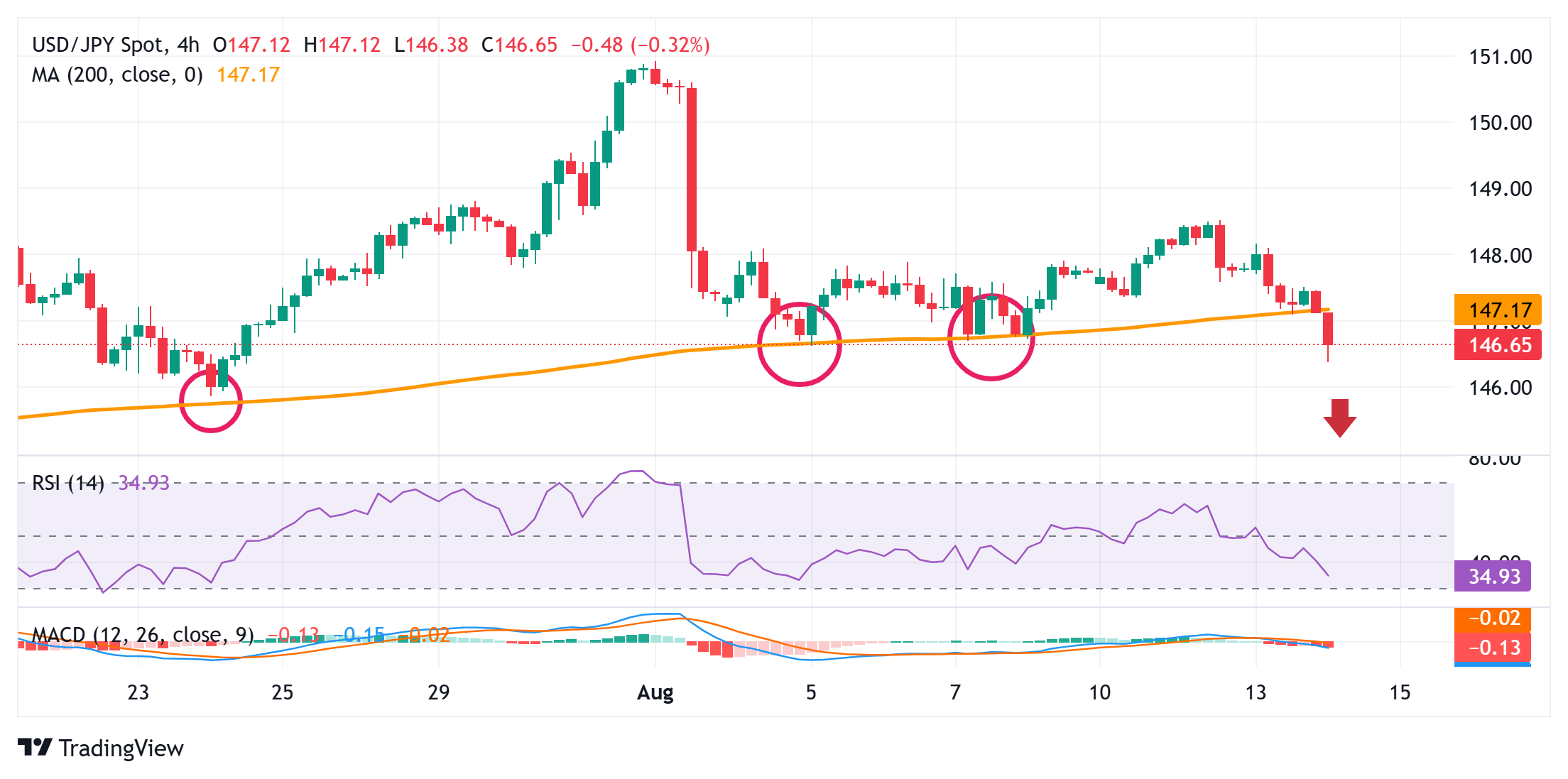Created
: 2025.08.14














![]() 2025.08.14 11:40
2025.08.14 11:40
The Japanese Yen (JPY) prolongs its uptrend against a broadly weaker US Dollar (USD) for the third straight day and spikes to over a three-week high during the Asian session on Thursday. The growing acceptance that the Bank of Japan (BoJ) will stick to the policy normalization path and hike interest rates by the end of this year continues to underpin the JPY. Meanwhile, hawkish BoJ expectations mark a big divergence in comparison to rising bets that the Federal Reserve (Fed) will restart its rate-cutting cycle in September. This, in turn, keeps the USD depressed near its lowest level in over two weeks and contributes to driving flows towards the lower-yielding JPY.
The aforementioned supporting factors, to a large extent, offset the prevalent risk-on environment and do little to dent a strong bullish sentiment surrounding the safe-haven JPY. Meanwhile, concern about consumption-led recovery amid a fall in Japan's real wages for the sixth straight month in June and the potential negative impact of higher US tariffs on the economy suggest that the prospects for further BoJ rate hikes could be delayed. This might hold back the JPY bulls from positioning for a runaway rally. Traders now look to the release of the US Producer Price Index (PPI) for some impetus later today, ahead of Japan's Preliminary Q2 GDP print on Friday.

From a technical perspective, an intraday breakdown and acceptance below the 200-period Simple Moving Average (SMA) on the 4-hour, around the 147.00 mark, could be seen as a fresh trigger for the USD/JPY bears. However, the Relative Strength Index on the said charts has moved to the verge of breaking into the oversold zone, making it prudent to wait for some intraday consolidation or a modest bounce before positioning for deeper losses. That said, any attempted recovery is more likely to attract fresh sellers and remain capped near the 147.00 support-turned-resistance. The latter should now act as a key pivotal point, which, if cleared decisively, could trigger a short-covering move towards the 147.45-147.50 region.
On the flip side, the USD/JPY pair seems poised to slide towards testing sub-146.00 levels (July 24 low) before extending the fall further to the next relevant support near the 145.40-145.30 region. The downward trajectory could eventually drag spot prices to the 145.00 psychological mark.
The Japanese Yen (JPY) is one of the world's most traded currencies. Its value is broadly determined by the performance of the Japanese economy, but more specifically by the Bank of Japan's policy, the differential between Japanese and US bond yields, or risk sentiment among traders, among other factors.
One of the Bank of Japan's mandates is currency control, so its moves are key for the Yen. The BoJ has directly intervened in currency markets sometimes, generally to lower the value of the Yen, although it refrains from doing it often due to political concerns of its main trading partners. The BoJ ultra-loose monetary policy between 2013 and 2024 caused the Yen to depreciate against its main currency peers due to an increasing policy divergence between the Bank of Japan and other main central banks. More recently, the gradually unwinding of this ultra-loose policy has given some support to the Yen.
Over the last decade, the BoJ's stance of sticking to ultra-loose monetary policy has led to a widening policy divergence with other central banks, particularly with the US Federal Reserve. This supported a widening of the differential between the 10-year US and Japanese bonds, which favored the US Dollar against the Japanese Yen. The BoJ decision in 2024 to gradually abandon the ultra-loose policy, coupled with interest-rate cuts in other major central banks, is narrowing this differential.
The Japanese Yen is often seen as a safe-haven investment. This means that in times of market stress, investors are more likely to put their money in the Japanese currency due to its supposed reliability and stability. Turbulent times are likely to strengthen the Yen's value against other currencies seen as more risky to invest in.
![]()
Created
: 2025.08.14
![]()
Last updated
: 2025.08.14

FXStreet is a forex information website, delivering market analysis and news articles 24/7.
It features a number of articles contributed by well-known analysts, in addition to the ones by its editorial team.
Founded in 2000 by Francesc Riverola, a Spanish economist, it has grown to become a world-renowned information website.
We hope you find this article useful. Any comments or suggestions will be greatly appreciated.
We are also looking for writers with extensive experience in forex and crypto to join us.
please contact us at [email protected].
Disclaimer:
All information and content provided on this website is provided for informational purposes only and is not intended to solicit any investment. Although all efforts are made in order to ensure that the information is correct, no guarantee is provided for the accuracy of any content on this website. Any decision made shall be the responsibility of the investor and Myforex does not take any responsibility whatsoever regarding the use of any information provided herein.
The content provided on this website belongs to Myforex and, where stated, the relevant licensors. All rights are reserved by Myforex and the relevant licensors, and no content of this website, whether in full or in part, shall be copied or displayed elsewhere without the explicit written permission of the relevant copyright holder. If you wish to use any part of the content provided on this website, please ensure that you contact Myforex.
Myforex uses cookies to improve the convenience and functionality of this website. This website may include cookies not only by us but also by third parties (advertisers, log analysts, etc.) for the purpose of tracking the activities of users. Cookie policy